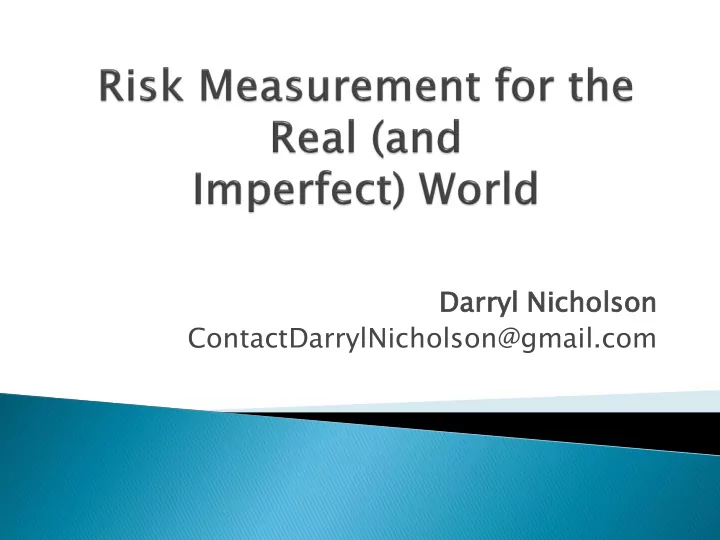

Darry ryl Nicholson olson ContactDarrylNicholson@gmail.com
Introduction Context / Background The Problem Scenarios & Calibration Scenario Lifecycle Deliverable Questions
Who am I and why am I here? Risk and Regression Testing Calibration of test plans Minimalistic approach to deliver sw quickly Our methods for Risk management Designed to drive revenue Fights natural instincts to be policeman/gatekeepers MRS – Minimum Regression Set Our implementation of Code coverage Controversial
SaaS Environment Our clients dictate schedules to sell services we build Hybrid SOA Production environment Process Billions of $$ in payments We are built for speed; wired for changes. Speed to Market is key Caution doesn’t pay the bills Compensation comes from driving revenue Cost to fix a Production bug is roughly equal to QA
Continuous Test Case Growth Customer review cycles and feedback New Clients & New Features Innovation in our product portfolio SOA enhancements that magnify the test problem Production test escapes
Result: Continuous test case growth in an unstructured quasi-subjective manner. Regression testing burden grows. Each new release cycle needs additional time and/or resources to complete Project Managers, Business Executives, Marketing and Customers never like this answer Not sustainable nor scalable
We chose to instrument our test cases using Code coverage techniques Resulting test case set from this analysis is the “Minimum Regression Set” (MRS) MRS easily maps to requirements, use cases, feature definitions, etc. All artifacts easily understood by key stakeholders.
UI : User Interface Layer MT: Middle Tier (Java) DB: DataBase Engineering team drives API & Code coverage unit tests with Cobertura Engineering has an extensive set of Unit tests that drive MT API’s but do not include the UI All feature complete QA releases have an instrumented MT.
Our clients tend to describe changes in terms of business use cases, marketing ideas or product delivery strategies rather than traditional software requirements. Client definition, in whatever form it arrives, is used to describe “Test Scenarios” Segregate out the test case data and refer to these elements as “Attributes”.
Process looks like this: Example: process credit card transactions from all states for different amounts and payment methods
A typical review for one of our web products will create 700-900 Scenarios. Creates Joint Ownership Are all defined Scenarios truly needed ?
Test Calibration is the process by which we create an MRS from the large set of Scenarios Classify in 3 categories: Cat 1: The MRS. Single Scenario that exercises a unique code path, is repeatable and measured Cat 2: A scenario that does not add code path uniqueness but adds unique data sets based on attributes Cat 3: A scenario that has neither code path uniqueness nor adds unique attribute data.
MRS Definition of Category 1 Instrumented MT-JAR file in the System Under Test Run each scenario to increase code coverage
Example from Cobertura home page Simply run Scenarios and verify coverage is increasing Goals: 100% API & code coverage.
Generally after execution of approximately a third of the defined Scenarios, the code coverage needle will stop incrementing far short of 100% coverage. This is the moment where we realize that the Scenarios analysis done as an intellectual exercise has missed a number of valid cases. Validation of the method!
Typically what is missed and overlooked: the error handling routines obscure use cases available functionality that was not obvious at review or “Snuck in” When running with code coverage enabled, these potential test escapes are very obvious.
After MRS is defined, a final UI Code review is required The White space is the UI code structures not measured since their scope is entirely in the UI Framework Examples: JQuery elements, Analytic web tags, form validation logic These are manually added to the MRS
Feedback loop Catch “feature Creep” Iterative and keeps conversation flowing
They happen. Root cause expressed as an MRS In our system, test escapes are generally: Automated test failure MRS Definition inaccuracy (missed) White Space analysis incorrect Scenario not executed First 3 = MRS additions 4 th Case is the price of too much speed & Risk
We live in an imperfect world. Accept - Deliver code with the “Sun & Moon alignment method” If we “Have to …” when QA has not finished testing then QA has a simple message for the team MRS = 45%.
Recommend
More recommend